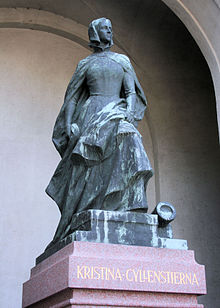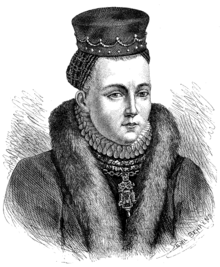Christina Gyllenstierna
She was a great-granddaughter of King Charles VIII of Sweden through her paternal grandmother princess Christina Karlsdotter Bonde (1432-1493/1500), heir of Fogelvik, after whom she was named.
On 16 November 1511 in Stockholm, she married the son of the Swedish regent Svante and the nephew of her former betrothed, Sten Sture the Younger.
She had six children during her marriage, but only one of them survived to adulthood: In 1512, Sten Sture succeeded his father as elected regent of Sweden upon his death.
At the death of his father, Sten was 18 years old, and High Councillor Eric Trolle, who supported the union with Denmark, was initially chosen as regent by the council.
However, Sten utilized the castles and troops granted to him by his late father and took power in a coup: after having promised to continue negotiations with Denmark, the High Council accepted him as regent instead of Trolle.
She took command of the city and Castle of Stockholm in the name of her underage son, and secured support from the majority of the peasantry and burgher class.
In late May, the Danish fleet arrived and the city of Stockholm was besieged by land and sea by the Danes under Christian II.
When the meeting was opened, the doors were closed and guarded, and archbishop Trolle accused her, her mother, her late spouse and the followers of Sture for his deposition and demanded compensation and punishment.
Previously advised by Didrik Slagheck and Jens Andersen Beldenak not to keep his word to heretics, he stated that the deposition of an archbishop was a crime against the church, and that a monarch had no jurisdiction to pardon anyone for heresy.
In effect, this meant that the king could in fact execute the participators in the rebellion against him despite the amnesty, by having them judged by the church for heresy rather than accused of treason by a secular court.
[2] Christina was held captive at Stockholm Castle until August 1521,[4] after which her children, mother, and finally herself were all transferred to the infamous Blåtårn ("Blue Tower") of Copenhagen Castle along with a large number of other women and children related to the executed of the Stockholm Bloodbath, among them her half sister Cecilia and nieces Emerentia and Margareta.
Hardly given enough each day to keep their lives but they worked to be fed":[1] King Gustav I of Sweden used their treatment in captivity in his propaganda against Christian II and claimed that the Danish monarch starved the women and children who only survived by the mercy showed them by the queen of Denmark, Isabella of Austria.
[1] Whatever the truth of this, it is confirmed that many of the imprisoned women and children died, among them Christina's daughter Magdalena, half sister Cecilia and niece Emerentia, though the cause of death are given as the plague, at that point used to classify a number of different illnesses.
[1] However, one source claims that Christina, in contrast to the other hostages, were not kept prisoner at Blue Tower but in Kalundborg, where she is confirmed to have been at least when the Swedish king later negotiated for her release.
[2] In summer 1524, King Gustav was informed by the mayor of Rostock and the Danish council that Christina planned to marry Søren Norby, Grand Admiral of Denmark and a follower of the deposed Danish king Christian II, in exchange for Norby using his fleet and military knowledge to help her conquer the Swedish throne for her son.
"[1] In March, the first of the Dalecarlian rebellions took place organized by Knut Mickelsson and Christina's former chancellor Peder Jakobsson (Sunnanväder), who glorified the reign of the Sture family in contrast to that of Gustav Vasa.
[1] The rebels reportedly contacted Søren Norby, who in the same month was promised by Christian II to be his governor in Sweden should he depose King Gustav.
[1] King Gustav sent Berend von Melen, married to his relative Margareta and governor of Kalmar Castle, to fight Norby.
[1] At this point, the von Melen couple left for Germany, leaving Nils and a garrison in Kalmar, which was sieged by the troops of Gustav I, while Christina herself seems to have been placed in arrest.
[5] On 20 July 1525, however, the rebellion was crushed when Nils, the son of Christina, was taken prisoner by King Gustav after his victory at the Siege of Kalmar.
In the official chronicle of the king, the elder son of Christina, Nils, is claimed to have died the year of his mother's remarriage.
[1] During the Westrogothian rebellion in 1529, Christina was given the task by the king to negotiate with her rebellious brother-in-law Jöran Turesson (Tre Rosor).
After the marriage of Margaret to the king, Christina and other relatives of the new queen were granted some privileges, such as the right to some of the money from the fines paid to the crown.


